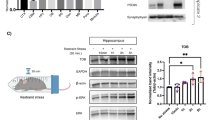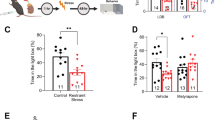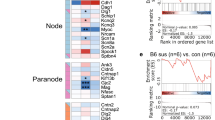Abstract
A minority of individuals experiencing traumatic events develop anxiety disorders. The reason for the lack of correspondence between the prevalence of exposure to psychological trauma and the development of anxiety is unknown. Extracellular proteolysis contributes to fear-associated responses by facilitating neuronal plasticity at the neuron–matrix interface1,2,3,4. Here we show in mice that the serine protease neuropsin is critical for stress-related plasticity in the amygdala by regulating the dynamics of the EphB2–NMDA-receptor interaction, the expression of Fkbp5 and anxiety-like behaviour. Stress results in neuropsin-dependent cleavage of EphB2 in the amygdala causing dissociation of EphB2 from the NR1 subunit of the NMDA receptor and promoting membrane turnover of EphB2 receptors. Dynamic EphB2–NR1 interaction enhances NMDA receptor current, induces Fkbp5 gene expression and enhances behavioural signatures of anxiety. On stress, neuropsin-deficient mice do not show EphB2 cleavage and its dissociation from NR1 resulting in a static EphB2–NR1 interaction, attenuated induction of the Fkbp5 gene and low anxiety. The behavioural response to stress can be restored by intra-amygdala injection of neuropsin into neuropsin-deficient mice and disrupted by the injection of either anti-EphB2 antibodies or silencing the Fkbp5 gene in the amygdala of wild-type mice. Our findings establish a novel neuronal pathway linking stress-induced proteolysis of EphB2 in the amygdala to anxiety.
This is a preview of subscription content, access via your institution
Access options
Subscribe to this journal
Receive 51 print issues and online access
$199.00 per year
only $3.90 per issue
Buy this article
- Purchase on Springer Link
- Instant access to full article PDF
Prices may be subject to local taxes which are calculated during checkout




Similar content being viewed by others
References
Gogolla, N., Caroni, P., Luthi, A. & Herry, C. Perineuronal nets protect fear memories from erasure. Science 325, 1258–1261 (2009)
Matys, T. et al. Tissue plasminogen activator promotes the effects of corticotropin-releasing factor on the amygdala and anxiety-like behavior. Proc. Natl Acad. Sci. USA 101, 16345–16350 (2004)
Pawlak, R., Magarinos, A. M., Melchor, J., McEwen, B. & Strickland, S. Tissue plasminogen activator in the amygdala is critical for stress-induced anxiety-like behavior. Nature Neurosci. 6, 168–174 (2003)
Pawlak, R. et al. Tissue plasminogen activator and plasminogen mediate stress-induced decline of neuronal and cognitive functions in the mouse hippocampus. Proc. Natl Acad. Sci. USA 102, 18201–18206 (2005)
Lupien, S. J., McEwen, B. S., Gunnar, M. R. & Heim, C. Effects of stress throughout the lifespan on the brain, behaviour and cognition. Nature Rev. Neurosci. 10, 434–445 (2009)
Roozendaal, B., McEwen, B. S. & Chattarji, S. Stress, memory and the amygdala. Nature Rev. Neurosci. 10, 423–433 (2009)
Lin, K. T., Sloniowski, S., Ethell, D. W. & Ethell, I. M. Ephrin-B2-induced cleavage of EphB2 receptor is mediated by matrix metalloproteinases to trigger cell repulsion. J. Biol. Chem. 283, 28969–28979 (2008)
Klein, R. Bidirectional modulation of synaptic functions by Eph/ephrin signaling. Nature Neurosci. 12, 15–20 (2009)
Pasquale, E. B. Eph-ephrin bidirectional signaling in physiology and disease. Cell 133, 38–52 (2008)
Chen, Z. L. et al. Expression and activity-dependent changes of a novel limbic-serine protease gene in the hippocampus. J. Neurosci. 15, 5088–5097 (1995)
Bouvier, D. et al. Pre-synaptic and post-synaptic localization of EphA4 and EphB2 in adult mouse forebrain. J. Neurochem. 106, 682–695 (2008)
Perrotti, L. I. et al. Induction of ΔFosB in reward-related brain structures after chronic stress. J. Neurosci. 24, 10594–10602 (2004)
Matsumoto-Miyai, K. et al. NMDA-dependent proteolysis of presynaptic adhesion molecule L1 in the hippocampus by neuropsin. J. Neurosci. 23, 7727–7736 (2003)
Shimizu, C. et al. Characterization of recombinant and brain neuropsin, a plasticity-related serine protease. J. Biol. Chem. 273, 11189–11196 (1998)
Dalva, M. B. et al. EphB receptors interact with NMDA receptors and regulate excitatory synapse formation. Cell 103, 945–956 (2000)
Grunwald, I. C. et al. Kinase-independent requirement of EphB2 receptors in hippocampal synaptic plasticity. Neuron 32, 1027–1040 (2001)
Takasu, M. A., Dalva, M. B., Zigmond, R. E. & Greenberg, M. E. Modulation of NMDA receptor-dependent calcium influx and gene expression through EphB receptors. Science 295, 491–495 (2002)
Binder, E. B. The role of FKBP5, a co-chaperone of the glucocorticoid receptor in the pathogenesis and therapy of affective and anxiety disorders. Psychoneuroendocrinology 34, S186–S195 (2009)
Binder, E. B. et al. Association of FKBP5 polymorphisms and childhood abuse with risk of posttraumatic stress disorder symptoms in adults. J. Am. Med. Assoc. 299, 1291–1305 (2008)
Binder, E. B. et al. Polymorphisms in FKBP5 are associated with increased recurrence of depressive episodes and rapid response to antidepressant treatment. Nature Genet. 36, 1319–1325 (2004)
Segman, R. H. et al. Peripheral blood mononuclear cell gene expression profiles identify emergent post-traumatic stress disorder among trauma survivors. Mol. Psychiatry 10, 500–513 (2005)
Genander, M. et al. Dissociation of EphB2 signaling pathways mediating progenitor cell proliferation and tumor suppression. Cell 139, 679–692 (2009)
Horii, Y., Yamasaki, N., Miyakawa, T. & Shiosaka, S. Increased anxiety-like behavior in neuropsin (kallikrein-related peptidase 8) gene-deficient mice. Behav. Neurosci. 122, 498–504 (2008)
Vyas, A., Mitra, R., Shankaranarayana Rao, B. S. & Chattarji, S. Chronic stress induces contrasting patterns of dendritic remodeling in hippocampal and amygdaloid neurons. J. Neurosci. 22, 6810–6818 (2002)
Hirata, A. et al. Abnormalities of synapses and neurons in the hippocampus of neuropsin-deficient mice. Mol. Cell. Neurosci. 17, 600–610 (2001)
Salter, M. G. & Fern, R. NMDA receptors are expressed in developing oligodendrocyte processes and mediate injury. Nature 438, 1167–1171 (2005)
Calo, L. et al. Interactions between ephrin-B and metabotropic glutamate 1 receptors in brain tissue and cultured neurons. J. Neurosci. 25, 2245–2254 (2005)
Brambilla, R. et al. A role for the Ras signalling pathway in synaptic transmission and long-term memory. Nature 390, 281–286 (1997)
Huang, Y. Y. & Kandel, E. R. 5-Hydroxytryptamine induces a protein kinase A/mitogen-activated protein kinase-mediated and macromolecular synthesis-dependent late phase of long-term potentiation in the amygdala. J. Neurosci. 27, 3111–3119 (2007)
Washburn, M. S. & Moises, H. C. Electrophysiological and morphological properties of rat basolateral amygdaloid neurons in vitro . J. Neurosci. 12, 4066–4079 (1992)
Acknowledgements
This work was supported by a Medical Research Council Project Grant (G0500231/73852), and a Marie Curie Excellence Grant (MEXT-CT-2006-042265 from the European Commission) to R. Pawlak, a Medisearch Fellowship to B.K.A., the Ministry of Education, Culture, Sports, Science and Technology of Japan (Grants-in-Aid, # 20300128) and Japan Science and Technology Agency (CREST program) to S.S., GENADDICT (LSHM-CT-2004-005166 from the European Commission) to R. Przewlocki, and NN405 274137 from the Ministry of Science and Higher Education of Poland to M.K. We are obliged to A. Kania, H. Castro and R. Fern for reagents. We are grateful to B. McEwen and A. Tobin for their comments on the manuscript and T. Gerdjikov, G. Mallucci and her laboratory members for advice.
Author information
Authors and Affiliations
Contributions
B.K.A., J.-M.B., S.P., M.M., E.S., A.E.S., K.W.Y. and R. Pawlak performed experiments and data analysis; R. Pawlak and B.K.A. designed most of the experiments; S.S. provided neuropsin−/− mice, suggestions and reagents; M.K., M.P. and R. Przewlocki performed bioinformatic analyses. R. Pawlak conceived the study and wrote the paper. All authors discussed the results and commented on the manuscript.
Corresponding author
Ethics declarations
Competing interests
The authors declare no competing financial interests.
Supplementary information
Supplementary Information
This file contains Supplementary Figures 1-20 with legends and additional references. (PDF 2924 kb)
Rights and permissions
About this article
Cite this article
Attwood, B., Bourgognon, JM., Patel, S. et al. Neuropsin cleaves EphB2 in the amygdala to control anxiety. Nature 473, 372–375 (2011). https://doi.org/10.1038/nature09938
Received:
Accepted:
Published:
Issue Date:
DOI: https://doi.org/10.1038/nature09938
This article is cited by
-
miR-483-5p offsets functional and behavioural effects of stress in male mice through synapse-targeted repression of Pgap2 in the basolateral amygdala
Nature Communications (2023)
-
Upregulation of KLK8 contributes to CUMS-induced hippocampal neuronal apoptosis by cleaving NCAM1
Cell Death & Disease (2023)
-
FKBP51 mediates resilience to inflammation-induced anxiety through regulation of glutamic acid decarboxylase 65 expression in mouse hippocampus
Journal of Neuroinflammation (2022)
-
Is kallikrein-8 a blood biomarker for detecting amnestic mild cognitive impairment? Results of the population-based Heinz Nixdorf Recall study
Alzheimer's Research & Therapy (2021)
-
Sex-dependent role for EPHB2 in brain development and autism-associated behavior
Neuropsychopharmacology (2021)
Comments
By submitting a comment you agree to abide by our Terms and Community Guidelines. If you find something abusive or that does not comply with our terms or guidelines please flag it as inappropriate.



